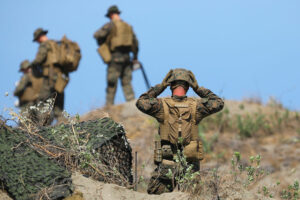US Marines prepare for military drills with Filipino counterparts this month
US MARINES and sailors arrived in Manila on Thursday to gear up for joint military exercises with their Filipino counterparts on Oct. 7 to 24 as part of their six-month stint in Southeast Asia, according to the US Defense department. In a statement, the agency’s Defense Visual Information Distribution Service said the visit to Manila […]

US MARINES and sailors arrived in Manila on Thursday to gear up for joint military exercises with their Filipino counterparts on Oct. 7 to 24 as part of their six-month stint in Southeast Asia, according to the US Defense department.
In a statement, the agency’s Defense Visual Information Distribution Service said the visit to Manila of the Marine Rotational Force in Southeast Asia (MRF-SEA) seeks to boost interoperability with allied forces in the Indo-Pacific region.
“We train together to strengthen our relationships and collective capabilities, and the intent of MRF-SEA is to cultivate and reinforce the common values and capabilities between our partners and to preserve a rules-based international order,” Colonel Stuart W. Glenn, commanding officer of the force, said in a statement.
He said the deployment of US Marines in Southeast Asia is aimed at building upon “cooperative relationships” with regional allies and partners.
“The Marine Corps is committed to preserving the freedom of the region and its people,” Mr. Glenn said.
The training exercises will involve ground and aircraft combat, combat medical care, military operations in urban terrain and at sea (amphibious operations), the US Defense department said.
“If the intention of joint military exercises is to strengthen Philippine-US interoperability for high availability disaster recovery, counterterrorism, combatting international crimes and other nontraditional security concerns, it is vital for Philippine capability building,” Rommel C. Banlaoi, president of the Philippine Society for International Security Studies, said in a Viber message.
“But if its intention is to counter China, the exercises will only cause regional anxieties,” he added.
Tensions between the Philippines and China have worsened in the past year as Beijing continues to block resupply missions to Second Thomas Shoal, where Manila has a handful of troops stationed at a beached vessel.
Washington had left its Typhon missile system in the Philippines after joint exercises in April amid Chinese demands to withdraw it from the Southeast Asian nation. The US does plan to pull it out and is studying its use in a regional conflict, Reuters earlier reported.
China and Russia have criticized the move, saying it could fuel an arms race in the region.
Manila is considering all security options that would deter Chinese aggression in the waterway, Philippine Defense Secretary Gilberto Eduardo Gerardo C. Teodoro, Jr. earlier said.
The US Army flew the Typhon, which can launch missiles including SM-6 missiles and Tomahawks with a range exceeding 1,600 kilometers (994 miles), to the Philippines in April in what it called a “historic first” and a “significant step in our partnership with the Philippines.”
The Philippines is open to acquiring the Typhon midrange missile system, Agusan del Norte Rep. Jose “Joboy” S. Aquino II said last month, as he sponsored the 2025 budget of the Defense department.
“The MRF-SEA is commendable since while it’s reinforcing allies in maritime Southeast Asia, it also involves Thailand, which despite being in mainland Southeast Asia and affected by Chinese presence, is industrialized enough to not be dependent on it,” Hansley A. Juliano, who teaches political science at the Ateneo de Manila University, said in a Facebook Messenger chat.
Senate President Francis “Chiz” G. Escudero earlier told foreign journalists that the Senate aims to ratify Manila’s reciprocal access agreement with Tokyo before the year ends.
The military pact, which was signed in July, eases the entry of equipment and troops for combat training from Japan and to ensure stability in the region amid growing tensions with China.
The Philippines has a visiting forces agreement with the United States and Australia. Tokyo, which hosts the biggest concentration of US forces abroad, has a similar deal with Australia and Britain, and is negotiating another with France.
A United Nations-backed tribunal based in the Hague in 2016 voided China’s expansive claims in the South China Sea for being illegal. Beijing has rejected the ruling. — John Victor D. Ordoñez























